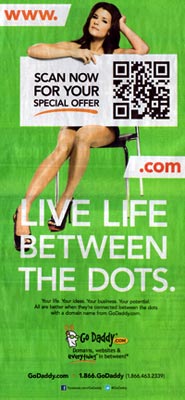 QR and other
mobile codes seem to be appearing everywhere. In fact, only 6% of ads carried a mobile code in the last quarter of 2011, according to Competitrack and its new survey of 7,300 mobile-activated ads it
catalogued last year. But that 6% of ads represented enormous growth from the 1% that occupied January issues.
QR and other
mobile codes seem to be appearing everywhere. In fact, only 6% of ads carried a mobile code in the last quarter of 2011, according to Competitrack and its new survey of 7,300 mobile-activated ads it
catalogued last year. But that 6% of ads represented enormous growth from the 1% that occupied January issues.
Overall, Competitrack says more than 2,300 advertisers used 2D codes in their ads
last year. The tactic remains primarily a print approach. According to company president Bob Moss: “We were monitoring 2D codes in six media: TV print, outdoor, online display, online video and
opt-in email. But about 96% of the codes we found were running in print.” Among the 11,000 outdoor ads Competitrack monitored in 24 markets, only 175 carried mobile codes.
Select advertisers are making very heavy use of the method for linking physical advertising with virtual assets. Competitrack counted 85% of Oppenheimer Funds ads having codes, 71% of Next Day
Blinds ads and 68% of Tag Heuer ads. On a monthly basis, 2D code use jumped markedly in the final quarter of the year, peaking throughout September through December for magazine issues at 6% of all
ads.
Retail advertisers accounted for 21.9% of ad code use in print. In fact, retail, technology (13.6%), financial services (6.7%) and cosmetics & personal care (6.3%) accounted for more
than half of codes.
Home Depot emerged as the clear leader in code use, as Competitrack located 121 campaigns that featured the approach. The home building and remodeling supplies retailer was
especially adept at using the context of their weekly circulars to offer specific calls to action that telegraphed to users what specialized content they would receive from a 2D code. The Competitrack
report even singled out Home Depot for using simple URLs that produced clean and clear QR codes that were easier to scan on many phone models.
While other code types
struggle for a toehold in the print market, advertisers continue to favor QR overwhelmingly -- found in 87.8% of ads. Microsoft’s Tag platform is a distant second at 10.2%, with others such as
JagTag, SnapTag, EZ Code and Datamatrix Code each accounting for less than .5% of use.
With mobile codes, it all comes down to the user experience and whether advertisers are delivering
something that makes the user interaction worth the effort. With the heavy use of codes among retailers, it is not surprising that 40.7% of these activations led consumers to product information, a
brand’s site or a purchase opportunity. But many marketers were focusing their landing experiences on branding efforts, with 23.2% of codes leading to some kind of engagement experience. Another
12.7% led to video, with some involving branding or product illustration. Only 7.8% of these placements led to sign-ups for continued communications with the brand or for contests. Another 3% led to
social network activities such as “liking” or “following” a brand. Only 2.2% initiated an app download and even fewer (1%) rendered a coupon.
Competitrack is
maintaining a database of 2D code advertisers and their campaigns. The full report is available at their site.